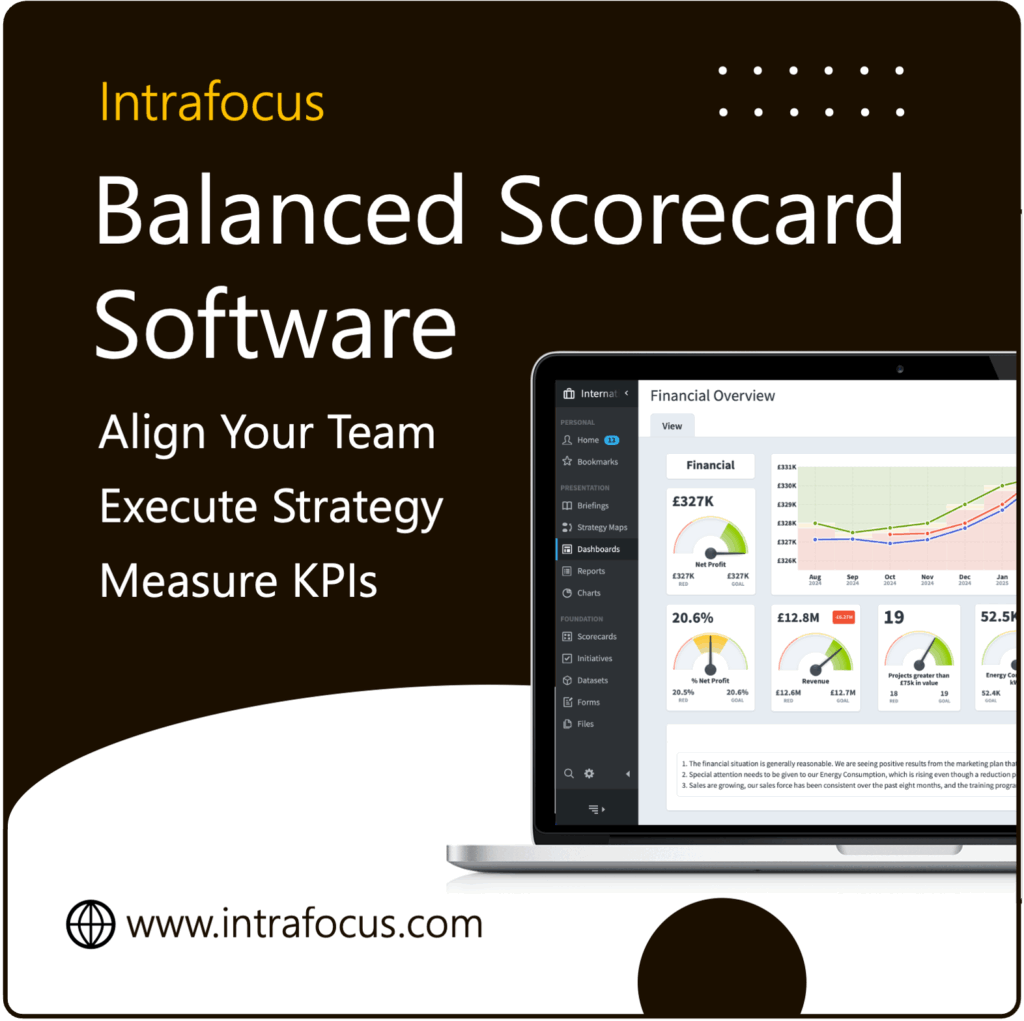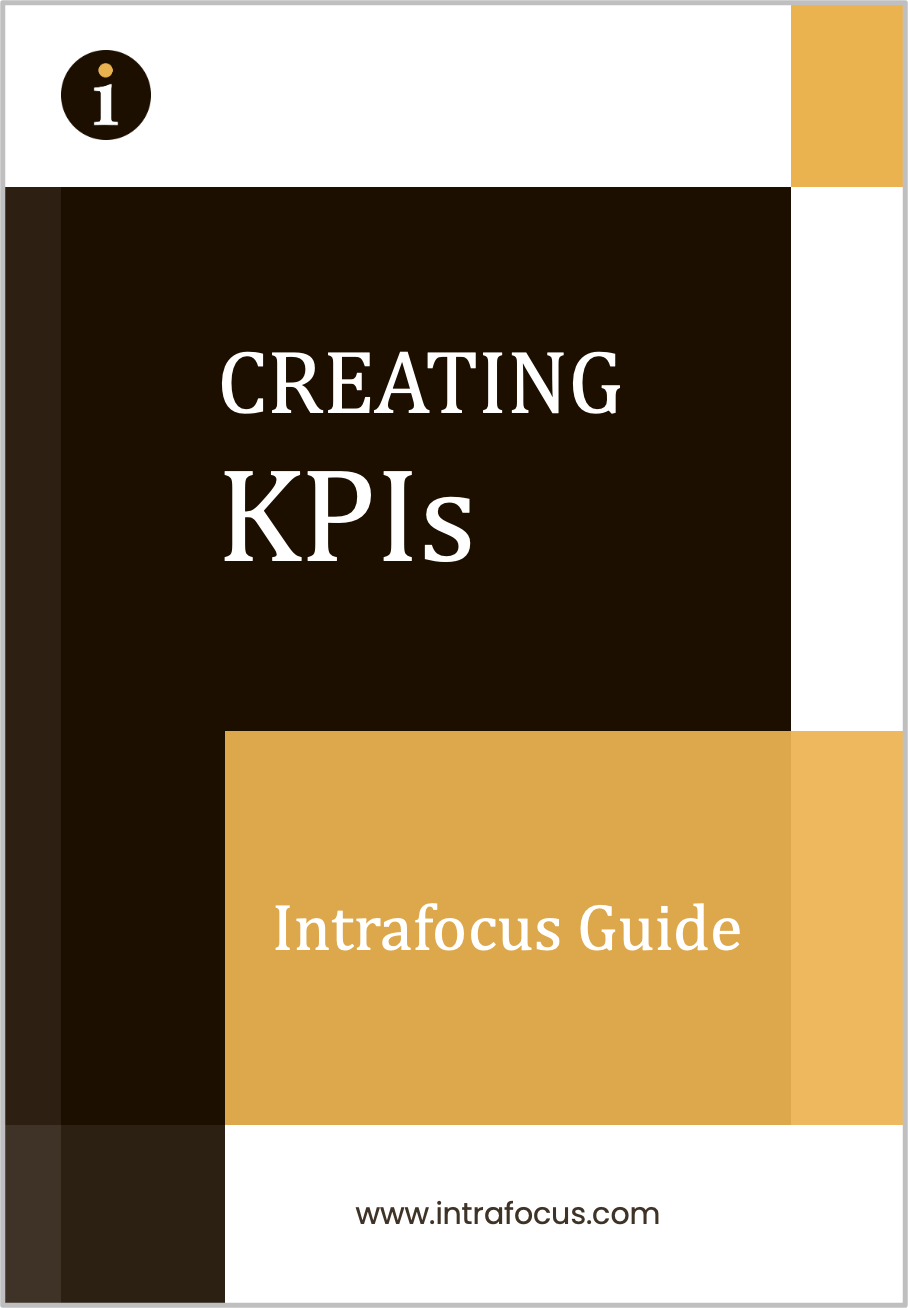Strategy’s Unseen Weak Spot
It’s a sobering statistic: 70% and 90% of strategies fail to deliver their intended results. That means that the most well-crafted strategic plans, no matter how insightful or ambitious, never make it off the whiteboard and into reality.
“It’s estimated that 60–90% of strategic plans never fully launch.”
Harvard Business Review, “Why Strategy Execution Unravels, and What to Do About It” (2015) by Donald Sull, Rebecca Homkes, and Charles Sull
Also recommended: KPI & Balanced Scorecard software | Intrafocus — implementation, training, and support.
But why? In our experience at Intrafocus, the problem isn’t poor strategy. It’s poor execution.
Business leaders often spend months refining their vision, running workshops, and outlining objectives, only to find, a year later, that very little has changed. The problem is the strategy execution gap: the disconnect between what an organisation sets out to achieve and what gets done.
This blog explores why that gap exists, what causes it, and, most importantly, what you can do to close it. Along the way, we’ll introduce you to the Balanced Scorecard (BSC), a proven method for aligning strategic intent with day-to-day activity, and how tools like Spider Impact can make that alignment visible, actionable, and measurable in real time.
Because at the end of the day, strategy isn’t about planning. It’s about performance.
What Is the Strategy Execution Gap?
The strategy execution gap refers to the chasm between an organisation’s strategic ambitions and the actual outcomes it delivers. It’s where good ideas die, not because they weren’t valid, but because they weren’t implemented effectively.
Here’s what the gap often looks like in real life:
- A leadership team announces bold new priorities, but departments keep doing the same things they did last quarter.
- KPIs exist, but nobody’s sure how they connect to strategic goals.
- Teams complete projects, but no one measures whether they move the needle.
This gap doesn’t emerge from laziness or lack of will. It comes from complexity, miscommunication, and a lack of systems that connect strategy to execution. The bigger and faster-moving the organisation, the more likely these disconnects will multiply.
The costs are steep: missed opportunities, wasted resources, disengaged employees, and failure to achieve your mission.
The solution? A method that ensures strategic objectives aren’t just defined, but translated, owned, and tracked throughout the organisation. That’s where the Balanced Scorecard comes in.
Five Common Causes of Strategy Execution Failure
Let’s take a closer look at why strategies fail once they move beyond the planning phase. Based on research and our consulting experience, five recurring issues are almost always present:
Lack of Strategic Clarity
If your team can’t describe your strategy in a sentence, or worse, if everyone gives a different answer, you have a clarity problem. Strategy must be crystal clear at every level of the organisation, not just to executives.
Symptoms:
- Vague mission statements
- Conflicting priorities
- Unclear success metrics
Disconnected KPIs and Metrics
Measurement matters—but only when it reflects what drives success. Many organisations fall into the trap of tracking what’s easy, not what’s strategic. That leads to:
- Vanity metrics that look good but mean little
- Lagging indicators with no predictive power
- Dashboards are overloaded with data, but lacking insight
No Ownership or Accountability
Strategic goals often fail because no one is responsible for achieving them. If everyone’s accountable, no one is.
Common pitfalls include:
- Initiatives with no owner
- Undefined roles or responsibilities
- Goals that are never reviewed or updated
Failure to Cascade the Strategy
The best strategies cascade down through the organisation, linking the big picture to daily activity. When that doesn’t happen:
- Middle managers and teams feel disconnected
- Objectives don’t influence planning or resourcing
- Frontline teams “work hard” without a clear strategic contribution
Lack of Real-Time Monitoring
Even the best-aligned plans can drift without ongoing visibility. If strategy review is an annual or quarterly ritual, you’re flying blind between check-ins. This results in:
- Missed risks or opportunities
- Inability to pivot fast
- Strategies falling out of sync with reality
The Balanced Scorecard Bridges the Strategy Execution Gap
The Balanced Scorecard (BSC) was created to address these breakdowns between strategic vision and operational execution. It provides a structured, visual way to translate strategy into action, ensuring everyone understands the plan, their role in delivering it, and how progress will be measured.
At its core, the BSC does three things exceptionally well:
Connects Vision to Execution
The BSC breaks strategy down into four interlinked perspectives:
- Financial – What financial outcomes do we need?
- Customer – What must we deliver to customers and stakeholders?
- Internal Processes – What must we excel at operationally?
- Organisational Capacity – How do we build the capabilities to sustain success?
By linking objectives across these dimensions, organisations create a strategy map that tells a clear, logical story of how value is created and sustained.
Aligns Teams and Initiatives
Each strategic objective in the BSC is supported by:
- KPIs (to measure success)
- Initiatives (to drive progress)
- Owners (to ensure accountability)
Alignment ensures strategy is cascaded, owned, and acted upon—not just admired in slide decks.
Enables Ongoing Performance Management
When paired with a tool like Spider Impact, the BSC becomes dynamic:
- Dashboards show progress in real time
- Alerts signal when goals are off track
- Teams can adjust initiatives before it’s too late
The Balanced Scorecard turns your strategic plan into a living system that adapts, evolves, and drives meaningful results.
The Role of AI in Improving Execution
Artificial intelligence is no longer limited to data science teams or IT departments. It is becoming a practical tool for enhancing strategic execution, especially in performance monitoring, risk identification, and decision making.
Used well, AI can help leadership teams:
- Detect early signs of execution risk, such as KPIs starting to drift
- Identify gaps or inconsistencies in progress tracking
- Recommend adjustments based on patterns in past data
For example, an AI-supported dashboard might alert a strategy owner that a key initiative is falling behind, even before a formal review. It might also surface that one department is managing too many priorities, making resource rebalancing necessary.
This kind of support helps leaders move from reactive to proactive management. But AI is not a substitute for judgment or leadership. It is an enhancer, providing better visibility, faster insights, and more informed choices.
When paired with software like Spider Impact, organisations gain more than dashboards. They get intelligent tools that drive action, not just reflection. The future of execution is not only digital but also smarter.
Three Practical Steps to Close Your Execution Gap
Understanding the execution gap is essential, but taking action makes the difference. Here are three steps that any organisation can take today to start closing the gap between strategy and results.
Reconnect Strategy with Daily Work
Start by reviewing your current objectives, KPIs, and projects. Make sure each one aligns with your strategic goals. If it does not, use a strategy map to clarify how they connect across the Balanced Scorecard perspectives.
Assign Ownership at Every Level
Every objective, measure, and initiative should have a clear owner. When ownership is visible, accountability increases. Use software tools to assign and track responsibility transparently.
Establish a Regular Review Process
Do not wait for year-end reviews. Introduce monthly or quarterly strategy check-ins, using live dashboards to guide discussion. This helps leadership teams adjust quickly and keeps strategy aligned with real-world performance.
Together, these actions build a culture where strategy is not just discussed, it is delivered.
What Comes Next
If closing the strategy execution gap is your first step, building a complete strategic planning system is your next.
The following article in this series will introduce the Intrafocus Seven-Step Strategic Planning Process. It is a practical and proven framework that helps organisations move from purpose and priorities through to measurement and automation.
It brings structure to strategy, clarity to communication, and discipline to execution. And if your strategy is only as strong as your ability to implement it, then this is the foundation you need to get it right.



